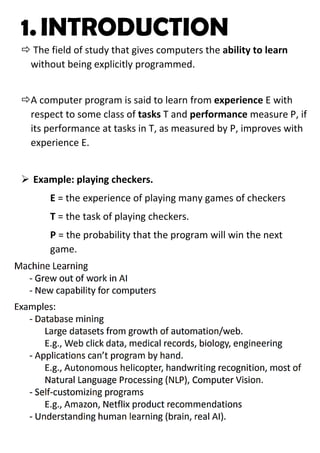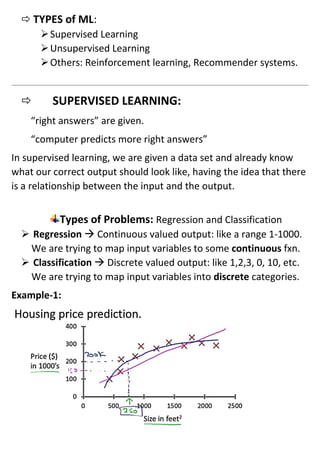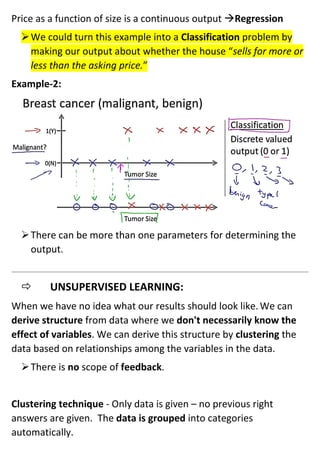1 Introduction to Machine Learning
- 1. 1.INTRODUCTION ’ā░ The field of study that gives computers the ability to learn without being explicitly programmed. ’ā░A computer program is said to learn from experience E with respect to some class of tasks T and performance measure P, if its performance at tasks in T, as measured by P, improves with experience E. Ō×ó Example: playing checkers. E = the experience of playing many games of checkers T = the task of playing checkers. P = the probability that the program will win the next game.
- 2. ’ā░ TYPES of ML: Ō×óSupervised Learning Ō×óUnsupervised Learning Ō×óOthers: Reinforcement learning, Recommender systems. ’ā░ SUPERVISED LEARNING: ŌĆ£right answersŌĆØ are given. ŌĆ£computer predicts more right answersŌĆØ In supervised learning, we are given a data set and already know what our correct output should look like, having the idea that there is a relationship between the input and the output. Types of Problems: Regression and Classification Ō×ó Regression ŌåÆ Continuous valued output: like a range 1-1000. We are trying to map input variables to some continuous fxn. Ō×ó Classification ŌåÆ Discrete valued output: like 1,2,3, 0, 10, etc. We are trying to map input variables into discrete categories. Example-1:
- 3. Price as a function of size is a continuous output ŌåÆRegression Ō×óWe could turn this example into a Classification problem by making our output about whether the house ŌĆ£sells for more or less than the asking price.ŌĆØ Example-2: Ō×óThere can be more than one parameters for determining the output. ’ā░ UNSUPERVISED LEARNING: When we have no idea what our results should look like.We can derive structure from data where we don't necessarily know the effect of variables. We can derive this structure by clustering the data based on relationships among the variables in the data. Ō×óThere is no scope of feedback. Clustering technique - Only data is given ŌĆō no previous right answers are given. The data is grouped into categories automatically.
- 4. Examples: Ō×ö Google news topics. Ō×ö Organising college clusters Ō×ö Social network analysis Ō×ö Market segmentation Ō×ö Astronomical data analysis Types: Clustering and Non-Clustering Ō×óClustering ŌåÆ Take a collection of 1,000,000 different genes, and find a way to automatically group these genes into groups that are somehow similar or related by different variables, such as lifespan, location, roles, and so on. Ō×óNon-Clustering ŌåÆ Ō×ö Cocktail party problem [W,s,v] = svd((repmat(sum(x.*x,1),size(x,1),1).*x)*xŌĆÖ); Allows you to find structure in a chaotic environment. (i.e. identifying individual voices and music from a mesh of sounds at a cocktail party).



![Examples:
Ō×ö Google news topics.
Ō×ö Organising college clusters
Ō×ö Social network analysis
Ō×ö Market segmentation
Ō×ö Astronomical data analysis
Types: Clustering and Non-Clustering
Ō×óClustering ŌåÆ Take a collection of 1,000,000 different genes,
and find a way to automatically group these genes into groups
that are somehow similar or related by different variables,
such as lifespan, location, roles, and so on.
Ō×óNon-Clustering ŌåÆ
Ō×ö Cocktail party problem
[W,s,v] = svd((repmat(sum(x.*x,1),size(x,1),1).*x)*xŌĆÖ);
Allows you to find structure in a chaotic environment. (i.e.
identifying individual voices and music from a mesh of sounds at
a cocktail party).](https://image.slidesharecdn.com/1introduction-200302155525/85/1-Introduction-to-Machine-Learning-4-320.jpg)